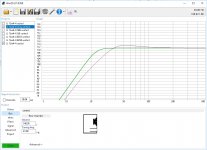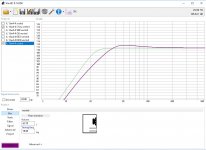I don't have a massive living room, probably about 300 square feet, compounded by a better half who is absolutely allergic to large black boxes in plain view.
I have managed to negotiate a pair of decent slim/deep floorstanders, satellite speakers and projector for the home cinema/hifi role but know that once subwoofers are involved, the objections will start up again.
I hope to head most of this off by either trimming the finished item off with real veneer to match the furniture or having it sprayed properly by the lads at the local garage but inevitably a big box will be more work to get past the camp commandant than a small one.
As a case in point I am playing with WinISD to compare vented box designs for a subwoofer the chaps over at the car audio forum very kindly identified for me.
The range of box size between the manufacturer recommended size and tuning frequency ( ~64 lts and 30Hz) to the recommended design by WinISD ( ~140 lts and 22Hz) with the former showing slightly more output but flat to 40hz and the latter being pretty flat down to 30hz.
It seems to me that the small increase in output at around 40-70 Hz from the smaller box isn’t worth the loss of extension compared to the larger box but don’t know how this would translate to real world listening.
If space was no issue then I would be building the bigger box.
Having not heard many subwoofers I am looking for some advice as to whether the extra box size is worth it for home cinema and 2.1 listening?
I have managed to negotiate a pair of decent slim/deep floorstanders, satellite speakers and projector for the home cinema/hifi role but know that once subwoofers are involved, the objections will start up again.
I hope to head most of this off by either trimming the finished item off with real veneer to match the furniture or having it sprayed properly by the lads at the local garage but inevitably a big box will be more work to get past the camp commandant than a small one.
As a case in point I am playing with WinISD to compare vented box designs for a subwoofer the chaps over at the car audio forum very kindly identified for me.
The range of box size between the manufacturer recommended size and tuning frequency ( ~64 lts and 30Hz) to the recommended design by WinISD ( ~140 lts and 22Hz) with the former showing slightly more output but flat to 40hz and the latter being pretty flat down to 30hz.
It seems to me that the small increase in output at around 40-70 Hz from the smaller box isn’t worth the loss of extension compared to the larger box but don’t know how this would translate to real world listening.
If space was no issue then I would be building the bigger box.
Having not heard many subwoofers I am looking for some advice as to whether the extra box size is worth it for home cinema and 2.1 listening?
Attachments
That's a huge box for a home-theatre 12" sub. Try modelling one of the Peerless XXLS subs.
When it comes to domestic subwoofers, remember your room is also at play here. Mine has a 9dB peak at 45Hz - imagine what that would do to any of the graphs you've made!
I find DSP-based EQ to be pretty much mandatory here.
Chris
When it comes to domestic subwoofers, remember your room is also at play here. Mine has a 9dB peak at 45Hz - imagine what that would do to any of the graphs you've made!
I find DSP-based EQ to be pretty much mandatory here.
Chris
It is rather! 
The purple line on the graph is from a box of less than half the volume(63lts), being in fact the recommended box size by the maker of the subwoofer I have (JL audio 12w4-4) .
It also works in a sealed box of only 36 litres, I just don’t know how much low end “rumble” in film material I would lose. I do see the appeal for 2.1 listening though.
Agreed in DSP eq, I’m just researching that now as it seems a huge field and I have no idea what bits of kit to look at.
The purple line on the graph is from a box of less than half the volume(63lts), being in fact the recommended box size by the maker of the subwoofer I have (JL audio 12w4-4) .
It also works in a sealed box of only 36 litres, I just don’t know how much low end “rumble” in film material I would lose. I do see the appeal for 2.1 listening though.
Agreed in DSP eq, I’m just researching that now as it seems a huge field and I have no idea what bits of kit to look at.
Attachments
Last edited:
I'd see if you can pick up a second-hand Behringer iNuke with DSP built-in. The NU3000DSP is a decent model - 300/600/1000w/ch into 8/4/2ohm. It'd be plenty for that 12", and you could add a second 12" and use both channels later.
When it comes to sealed boxes and EQ, here's the rundown:
A small sealed box tries very hard to stop the cone moving. Therefore, the efficiency in the low bass is also low.
A larger sealed box allows the cone to move more easily, so efficiency is higher. You don't need to much power to get the cone moving.
So long as the driver is allowed to reach it's mechanical limits, sealed boxes all have the same maximum SPL available.
With a large sealed box, it might take 50 watts to hit Xmax (and therefore put out maximum SPL), while a small sealed box might take 500 watts. They'd both be putting out the same SPL at that point.
Now, when high power levels are presented to a driver, the voice coil and magnet will introduce some distortion, on account of neither of them being the theoretical "perfect" magnet and coil.
Larger boxes need less power, so that directly translates into lower distortion.
When it comes to sealed boxes, you can EQ for any frequency response you like. -3dB at 1Hz? Sure, no problem. So long as you don't try to exceed 40dB.
A sensible figure for a 12" in a UK-sized living room would be aiming for a -3dB point around 25Hz.
ie, if you EQ to be flat to 25Hz, you can go up to around 100dB (plus room gain) before the driver runs out of excursion should some 25Hz content come along. I'd say that's loud enough for most domestic situations.
Chris
When it comes to sealed boxes and EQ, here's the rundown:
A small sealed box tries very hard to stop the cone moving. Therefore, the efficiency in the low bass is also low.
A larger sealed box allows the cone to move more easily, so efficiency is higher. You don't need to much power to get the cone moving.
So long as the driver is allowed to reach it's mechanical limits, sealed boxes all have the same maximum SPL available.
With a large sealed box, it might take 50 watts to hit Xmax (and therefore put out maximum SPL), while a small sealed box might take 500 watts. They'd both be putting out the same SPL at that point.
Now, when high power levels are presented to a driver, the voice coil and magnet will introduce some distortion, on account of neither of them being the theoretical "perfect" magnet and coil.
Larger boxes need less power, so that directly translates into lower distortion.
When it comes to sealed boxes, you can EQ for any frequency response you like. -3dB at 1Hz? Sure, no problem. So long as you don't try to exceed 40dB.
A sensible figure for a 12" in a UK-sized living room would be aiming for a -3dB point around 25Hz.
ie, if you EQ to be flat to 25Hz, you can go up to around 100dB (plus room gain) before the driver runs out of excursion should some 25Hz content come along. I'd say that's loud enough for most domestic situations.
Chris
I suppose the next step is to buy a test microphone of some sort and work out how much room gain (and loss) there actually is?
Good article about room gain here:
Data-Bass
A USB mic (e.g. UMIK-1) is good for most measurement duties - pretty cheap, simple to use, and is an easy way to make those sorts of graphs yourself.
However, if this specific task is the only thing you'd ever use a microphone for, maybe you don't need to make the purchase. You don't really need that much detail. A spectrum analyser app on a smartphone might be enough.
Without a calibrated microphone, the data won't be perfect (it might tell you a peak is +8dB when it is actually +11dB), but it will still show you where the peaks are / what your room is doing.
Hooray for hollowboy. Using good lab methods, you don't need a fancy mic. But even so-so measurements sure blow subjective impressions out of the water.However, if this specific task is the only thing you'd ever use a microphone for, maybe you don't need to make the purchase. You don't really need that much detail. A spectrum analyser app on a smartphone might be enough.
Without a calibrated microphone, the data won't be perfect (it might tell you a peak is +8dB when it is actually +11dB), but it will still show you where the peaks are / what your room is doing.
My MacBook laptop mic works surprisingly well.
You can use your laptop mic - diyAudio
B.
That's a huge box for a home-theatre 12" sub.
Chris
You need to go to avsforum.com. 4ft3 boxes are small for home theater (20hz). Guys are putting 18's in 4ft3 sealed just for near field impact behind the couch.
you could also consider unconventional form factors and locations. For example suspended from the ceiling or wall mounted. Also having more sub woofers in uncorrelated locations helps with reducing room issues in comparison to a single sub:
https://www.harman.com/sites/default/files/multsubs_0.pdf
https://www.harman.com/sites/default/files/multsubs_0.pdf
Yes. I'm always advocating for heterogeneity and stochastic variety whenever beneficial in speakers. But seems to go against the theory DNA of many who post here....Also having more sub woofers in uncorrelated....
B.
- Status
- This old topic is closed. If you want to reopen this topic, contact a moderator using the "Report Post" button.
- Home
- Loudspeakers
- Subwoofers
- Performance per unit "living room space"?

